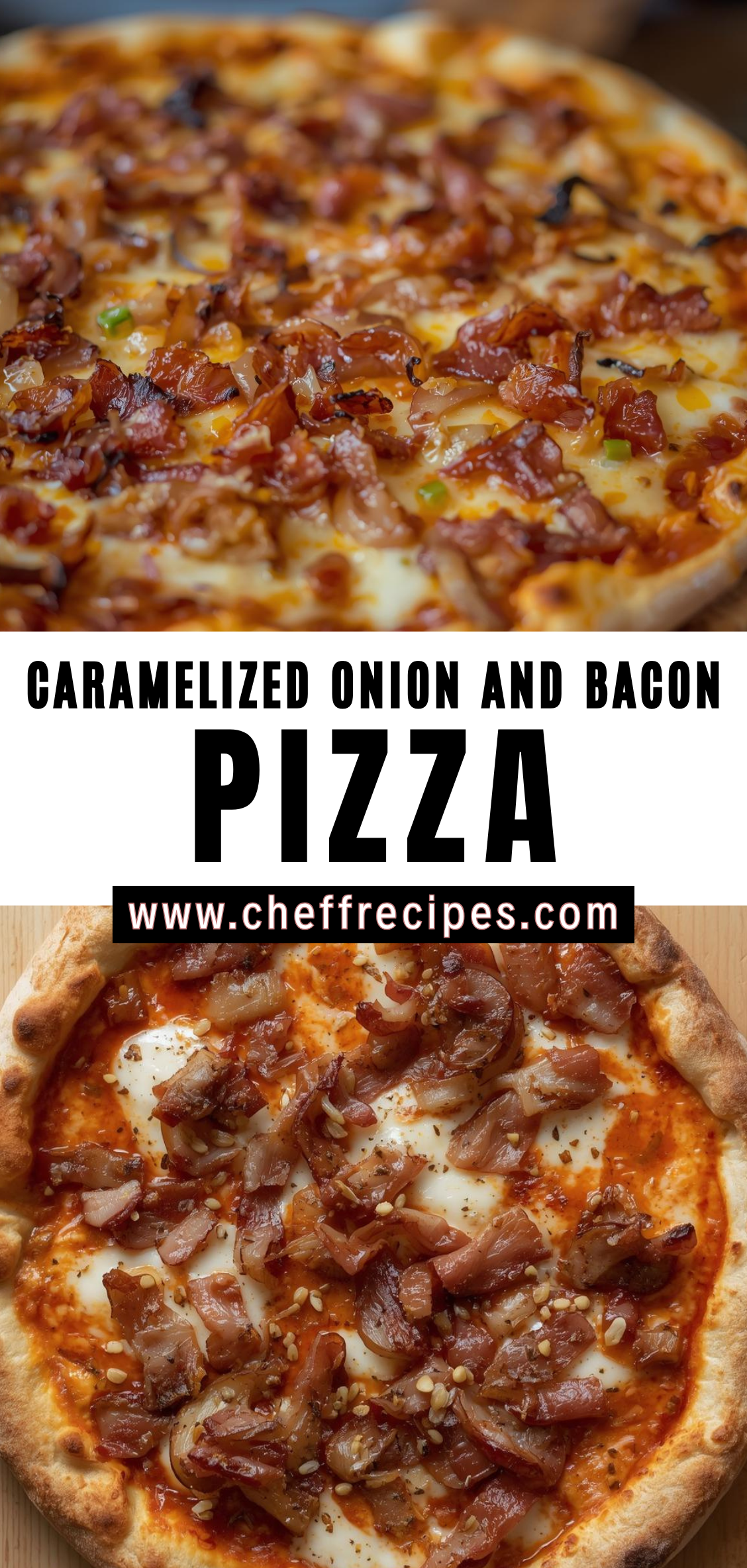Pizza is one of the most universally celebrated dishes in the culinary world. Its origins are humble, yet its reach is extraordinary — from the bustling streets of Naples to modern artisanal pizzerias in cosmopolitan cities. Though traditionally associated with simple tomato, cheese, and bread, pizza has evolved into a canvas for endless creativity. Among the myriad combinations that grace this iconic dish, Caramelized Onion and Bacon Pizza stands out as a masterful balance of savory richness, subtle sweetness, and textural contrast.

At first glance, the appeal is obvious: the deep, golden brown of slowly caramelized onions evokes warmth and complexity, while the crispy, smoky bacon provides an irresistible counterpoint. Each bite delivers a harmony of flavors — a contrast of sweet and salty, soft and crunchy, mild and robust — that excites the palate and satisfies the soul. This pizza is more than a meal; it is an experience, a journey through layers of flavor built on technique, patience, and quality ingredients.
The magic of caramelized onions lies in their transformation. When onions are cooked slowly over low heat, their natural sugars break down, producing a rich, sweet, almost umami-like depth that cannot be replicated by raw or quickly sautéed onions. This labor of love — the gentle patience required to coax the onions to a golden, sticky perfection — is a metaphor for the essence of cooking itself: the art of coaxing maximum flavor from simple ingredients. Caramelized onions are not just an ingredient; they are a technique that elevates a dish, transforming ordinary onions into a luxurious, complex layer that anchors the pizza.
Bacon, on the other hand, is all about immediate gratification. Its salty, smoky flavor is a perfect foil to the sweetness of the onions. The crispiness of well-cooked bacon adds textural contrast to the tender crust and gooey cheese, creating a multi-sensory experience in every bite. The marriage of these two ingredients — slow, sweet, and savory onions with quick, crispy, salty bacon — exemplifies the culinary principle of balance, a theme that runs throughout exceptional cooking.
This pizza also highlights the beauty of dough as more than just a base. Whether one opts for a traditional Neapolitan-style thin crust or a thick, chewy artisan crust, the dough serves as the foundation for flavor exploration. Its texture and structure support the toppings while contributing its own subtle flavor profile, particularly if allowed to ferment and develop naturally over time. The gentle fermentation process introduces nuanced aromas and slight tanginess that contrast beautifully with the sweet and savory toppings. In essence, great pizza begins with great dough, and everything else builds upon it.
From a nutritional perspective, this pizza demonstrates both indulgence and opportunity. Bacon is rich in protein and savory fat that enhances satiety, while onions contribute fiber, antioxidants, and a delicate sweetness without added sugar. By choosing whole grain or artisan dough, one can further introduce complex carbohydrates and micronutrients, creating a pizza that is both flavorful and more nourishing than its fast-food counterparts. Cheese, of course, contributes calcium, protein, and creaminess — but it is best appreciated when balanced thoughtfully with the other ingredients, rather than used excessively.
The cultural history of pizza adds another layer of appreciation. Originating in Naples as a humble, street-food staple for working-class families, pizza has evolved globally into countless interpretations. The Caramelized Onion and Bacon variation represents a contemporary twist on tradition, reflecting both gourmet sensibilities and comfort-food nostalgia. It combines Old World techniques — caramelization, careful layering of flavors, dough fermentation — with modern preferences for bold, layered taste experiences. This pizza is at once familiar and elevated, accessible yet sophisticated.
The preparation of this pizza is also a lesson in culinary timing and technique. The caramelization of onions requires patience and attention; the bacon must be cooked to the perfect crispness without burning; the dough must achieve the ideal balance of elasticity and crunch. Even the choice of cheese — whether a classic mozzarella, a tangy fontina, or a creamy gouda — can dramatically influence flavor harmony. Each element contributes not only to taste but also to the visual appeal: golden caramelized strands, crisp reddish-brown bacon edges, and bubbling, slightly browned cheese.
One cannot discuss this pizza without acknowledging the sensory experience it offers. The aroma of caramelized onions mingling with smoky bacon wafts from the oven and fills the kitchen, creating anticipation before the first bite. The visual presentation — glossy onion strands, perfectly browned bacon, and bubbling cheese atop a golden crust — signals indulgence and craft. When tasted, the layers of flavor unfold sequentially: the initial sweet bite of the onions, followed by the savory crunch of bacon, the creamy richness of melted cheese, and the tender chew of dough. Each bite is a microcosm of balance, texture, and satisfaction.
Detailed Instructions
1. Preparing the Dough (Foundation of the Pizza)
The dough is the backbone of any great pizza. Its texture, chew, and flavor significantly affect the final product. Taking time to prepare the dough correctly ensures a crisp crust with a tender interior.
Step 1: Gather Ingredients for Dough
-
3 ½ cups all-purpose or bread flour
-
1 teaspoon salt
-
1 teaspoon sugar
-
1 packet (2 ¼ teaspoons) active dry yeast
-
1 ¼ cups warm water (105–110°F / 40–43°C)
-
2 tablespoons olive oil
Step 2: Activate Yeast
-
In a small bowl, combine warm water, sugar, and yeast. Stir gently and let sit 5–10 minutes until foamy. This confirms the yeast is active and will allow proper fermentation.
Step 3: Mixing the Dough
-
In a large mixing bowl, combine flour and salt.
-
Make a well in the center and add yeast mixture and olive oil.
-
Mix with a wooden spoon or hands until dough begins to form.
Step 4: Kneading
-
Transfer dough to a floured surface and knead 8–10 minutes until smooth and elastic.
-
Proper kneading develops gluten, which gives the dough chew and structure.
Step 5: First Rise
-
Place the dough in a lightly oiled bowl, cover with a damp cloth or plastic wrap.
-
Let it rise in a warm place for 1–2 hours, or until doubled in size.
Step 6: Shaping
-
Punch down the dough to release excess gas.
-
Divide if making multiple pizzas. Roll or stretch dough into desired size and thickness.
Culinary Tip:
For extra flavor, allow dough to ferment in the refrigerator for 24–48 hours. This slow fermentation develops a subtle tang and richer aroma.
2. Caramelizing Onions (Building Sweet Depth)
Caramelized onions are the heart of this pizza’s flavor. Slow cooking transforms their sharpness into sweet, umami-rich strands.
Step 1: Prepare Onions
-
Peel and thinly slice 2–3 large yellow onions into ¼-inch slices.
Step 2: Heat Pan
-
In a large skillet, heat 1–2 tablespoons olive oil or butter over medium-low heat.
Step 3: Sauté Onions Slowly
-
Add onions to the pan, stirring to coat in oil.
-
Cook slowly for 25–35 minutes, stirring every few minutes to prevent sticking or burning.
Step 4: Add Sweetener (Optional)
-
For deeper sweetness, sprinkle ½ teaspoon sugar or drizzle a small amount of honey halfway through cooking.
-
Deglaze pan with 1–2 teaspoons balsamic vinegar near the end to enhance caramelization and add complexity.
Step 5: Finish
-
Onions should be deeply golden brown, soft, and slightly sticky.
-
Remove from heat and set aside to cool slightly.
Culinary Note:
Patience is key — rushing this step with high heat can lead to burnt, bitter onions instead of sweet, flavorful ones.
3. Cooking the Bacon (Crispy, Smoky Layer)
Bacon provides saltiness, smokiness, and crisp texture that contrasts perfectly with sweet onions.
Step 1: Select Bacon
-
Choose thick-cut, high-quality bacon for maximum flavor and texture.
Step 2: Cook Bacon
-
In a skillet over medium heat, cook bacon until crispy, about 6–10 minutes depending on thickness.
-
Transfer to a paper towel-lined plate to drain excess fat.
Step 3: Chop
-
Once cooled slightly, chop bacon into bite-sized pieces for even distribution on the pizza.
Pro Tip:
Slightly undercooking bacon is okay if finishing in the oven — it will crisp further while baking.
4. Preparing the Cheese and Other Toppings
Cheese acts as the glue that binds the toppings and adds creamy richness. Choosing the right cheese can elevate the pizza.
Step 1: Cheese Selection
-
Classic mozzarella is ideal for meltiness and mild flavor.
-
Optional additions: fontina, gouda, or parmesan for layered complexity.
Step 2: Grate or Slice
-
Grate cheese evenly for consistent melting.
-
For hard cheeses like parmesan, finely grate for a subtle finishing touch.
Step 3: Other Optional Toppings
-
Fresh herbs like thyme or rosemary complement bacon and onions.
-
Small amounts of arugula or baby spinach can be added after baking for freshness.
5. Assembling the Pizza
Proper assembly ensures even cooking and balanced flavor.
Step 1: Preheat Oven
-
Preheat oven to 475°F (245°C), ideally with a pizza stone for a crisp crust.
Step 2: Prepare Dough Base
-
Roll out dough to desired thickness on a floured surface.
-
Transfer to parchment paper or preheated pizza stone.
Step 3: Layer Ingredients
-
Brush dough lightly with olive oil to prevent sogginess.
-
Evenly spread a thin layer of caramelized onions.
-
Sprinkle cheese over onions, covering evenly but leaving a border for the crust.
-
Distribute bacon pieces evenly on top.
-
Add any additional herbs or optional toppings.
Step 4: Season
-
Lightly sprinkle with black pepper or a pinch of sea salt, if needed.
6. Baking the Pizza
Step 1: Transfer to Oven
-
Slide pizza onto preheated pizza stone or baking sheet.
Step 2: Bake
-
Bake 12–15 minutes, or until cheese is bubbling and golden, crust is crisp and slightly charred at edges.
-
Rotate halfway through baking for even cooking if not using a pizza stone.
Step 3: Check Doneness
-
Cheese should be melted and slightly browned.
-
Crust should sound hollow when tapped.
Pro Tip:
For extra crispy edges, finish under the broiler for 1–2 minutes, watching carefully to prevent burning.
7. Finishing Touches and Serving
Step 1: Resting
-
Let pizza rest 2–3 minutes after baking to allow cheese to set slightly.
Step 2: Garnishing
-
Optionally top with fresh herbs like parsley, thyme, or arugula.
-
Drizzle a small amount of balsamic glaze for added depth and visual appeal.
Step 3: Slicing and Serving
-
Slice with a pizza cutter or sharp knife into even pieces.
-
Serve immediately to enjoy optimal texture and flavor.
Culinary Note:
The combination of sweet caramelized onions, smoky bacon, and molten cheese atop a crisp, golden crust delivers a multi-layered, sensory experience that is the hallmark of great pizza.
Caramelized Onion and Bacon Pizza
Pizza is one of the most universally celebrated dishes in the culinary world. Its origins are humble, yet its reach is extraordinary — from the bustling streets of Naples to modern artisanal pizzerias in cosmopolitan cities. Though traditionally associated with simple tomato, cheese, and bread, pizza has evolved into a canvas for endless creativity. Among the myriad combinations that grace this iconic dish, Caramelized Onion and Bacon Pizza stands out as a masterful balance of savory richness, subtle sweetness, and textural contrast.
Ingredients
- For the crust:
- 1 lb (450 g) store-bought pizza dough or homemade dough
- For the topping:
- 3 tablespoons olive oil
- 2 large onions, thinly sliced
- 6–8 slices bacon, cooked and chopped
- 1½ cups shredded mozzarella cheese
- ½ cup crumbled goat cheese or feta (optional for tang)
- 1 teaspoon fresh thyme or rosemary (optional)
- Salt and black pepper to taste
- 1–2 tablespoons balsamic vinegar (optional, for finishing)
Instructions
Notes
- Make it lighter: Use part-skim mozzarella and turkey bacon or reduce the amount of cheese.
- Vegetarian option: Skip the bacon and add mushrooms or roasted red peppers.
- Make-ahead: Caramelize onions and cook bacon a day ahead to save prep time.
- Flavor tip: Fresh arugula added after baking gives a peppery contrast.


